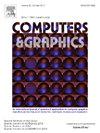On-site single image SVBRDF reconstruction with active planar lighting
IF 2.5
4区 计算机科学
Q2 COMPUTER SCIENCE, SOFTWARE ENGINEERING
引用次数: 0
Abstract
Recovering the spatially-varying bidirectional reflectance distribution function (SVBRDF) from a single image in uncontrolled environments is challenging while essential for various applications. In this paper, we address this highly ill-posed problem using a convenient capture setup and a carefully designed reconstruction framework. Our proposed setup, which incorporates an active extended light source and a mirror hemisphere, is easy to implement for even common users and requires no careful calibration. These devices can simultaneously capture uncontrolled lighting, real active lighting patterns, and material appearance in a single image. Based on all captured information, we solve the reconstruction problem by designing lighting clues that are semantically aligned with the input image to aid the network in understanding the captured lighting. We further embed lighting clue generation into the network’s forward pass by introducing real-time rendering. This allows the network to render accurate lighting clues based on predicted normal variations while jointly learning to reconstruct high-quality SVBRDF. Moreover, we also use captured lighting patterns to model noises of pattern display in real scenes, which significantly increases the robustness of our methods on real data. With these innovations, our method demonstrates clear improvements over previous approaches on both synthetic and real-world data.

现场单幅图像SVBRDF重建与主动平面照明
在不受控制的环境中,从单幅图像中恢复空间变化的双向反射分布函数(SVBRDF)是一项具有挑战性的工作,但对于各种应用来说都是必不可少的。在本文中,我们使用方便的捕获设置和精心设计的重建框架来解决这个高度不适定的问题。我们提出的设置,包括一个有源扩展光源和一个镜像半球,即使是普通用户也很容易实现,不需要仔细校准。这些设备可以同时捕捉不受控制的照明,真正的主动照明模式,并在一个单一的图像材料外观。基于所有捕获的信息,我们通过设计与输入图像语义一致的照明线索来解决重建问题,以帮助网络理解捕获的照明。通过引入实时渲染,我们进一步将光照线索生成嵌入到网络的前向传递中。这使得网络可以根据预测的正常变化呈现准确的照明线索,同时共同学习重建高质量的SVBRDF。此外,我们还使用捕获的照明模式来模拟真实场景中模式显示的噪声,这大大提高了我们的方法对真实数据的鲁棒性。通过这些创新,我们的方法在合成数据和实际数据上都比以前的方法有了明显的改进。
本文章由计算机程序翻译,如有差异,请以英文原文为准。
求助全文
约1分钟内获得全文
求助全文
来源期刊

Computers & Graphics-Uk
工程技术-计算机:软件工程
CiteScore
5.30
自引率
12.00%
发文量
173
审稿时长
38 days
期刊介绍:
Computers & Graphics is dedicated to disseminate information on research and applications of computer graphics (CG) techniques. The journal encourages articles on:
1. Research and applications of interactive computer graphics. We are particularly interested in novel interaction techniques and applications of CG to problem domains.
2. State-of-the-art papers on late-breaking, cutting-edge research on CG.
3. Information on innovative uses of graphics principles and technologies.
4. Tutorial papers on both teaching CG principles and innovative uses of CG in education.
 求助内容:
求助内容: 应助结果提醒方式:
应助结果提醒方式:


